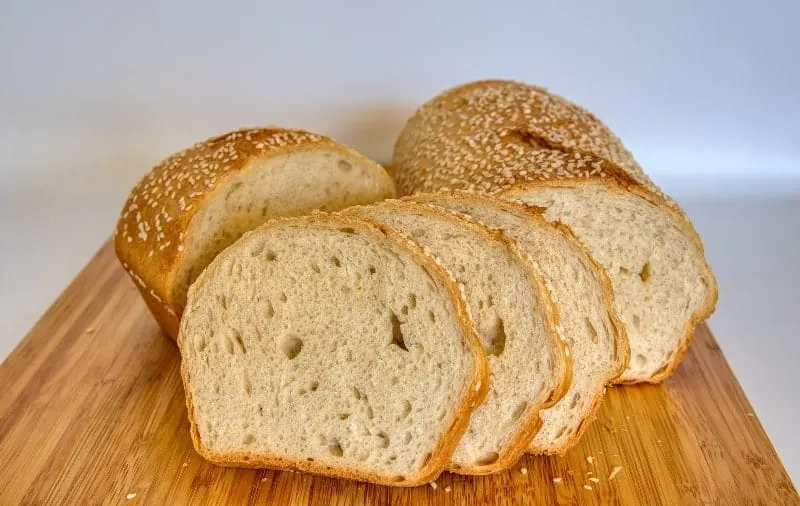Baking a loaf of bread that’s beautifully risen and golden-brown is great. Well, it’s great until you take a smell or bite out of it and get an awful yeasty flavor.
The reason you bake bread is to get better and healthier bread overall, so it’s disheartening when it turns out to be yeasty.
When bread has a yeasty flavor, it’s often because of two reasons. You may have added too much yeast to your dough or you’ve risen it too quickly. Eliminating the yeasty flavor can be done by using considerably less yeast combined with a long bulk fermentation.
To simplify things, a long bulk fermentation (first proof) will help the bad flavors in your dough to break down into nice flavor. With enough time, this will get rid of that unpleasant yeasty flavor and smell.
Nearly all good bakers choose a considerably longer bulk ferment over a shorter one since it creates a much more complex network of flavors and adds so much more to the dough.
Even if you don’t get a yeasty flavor in some bread, a longer bulk ferment will do wonders for the overall flavor of your bread and you won’t regret it.
What You Can Do To Prevent A Yeasty Flavor In Your Bread
Like I’ve said, the causes of a yeasty bread are as follows:
- Too Much Yeast In Your Recipe
- The Dough Has Risen Too Fast
It’s all well and good knowing this, but what can you do to prevent this awful flavor next time?
As a baker, it’s important to understand what makes bread taste great. The most simple thing you can do to improve a bread’s overall texture and flavor is to give it more time. By giving your dough time to ferment, you’re allowing a whole load of activity to go on inside it.
Leaving a dough in a warm place like your oven or near it can improve your dough’s rise, but it isn’t always a good thing. Personally, I wouldn’t recommend speeding up the rise of your dough too much as it can leave the flavor of your dough lacking. Instead, go for a much longer bulk fermentation.
During a nice long fermentation, a lot of activity and changes go on in your dough. Before proofing, there are a lot of molecules that taste terrible, so we need to get rid of these before we bake the bread. During a long proof, these bad-tasting molecules are broken down into molecules that taste far better.
Over this fermentation, you want to get rid of as many as those nasty flavors as possible and replace them with the better flavors you get from breaking them down, so it’s important to not speed up your rise.
These long proofs introduce a whole new spectrum of complex flavors to shine through your loaf. If you were to just go by a standard recipe and proof your dough for around 60 minutes, you’re not allowing enough of those molecules to break down, so you’re not going to get the great flavor you get from an extended rise.
How To Slow Down Your Dough’s Bulk Fermentation & Introduce Better Flavours
Yeast plays a huge role in creating texture and rise in your bread and it’s easy to think that your dough needs a specific amount of yeast to rise it properly.
A mistake I often made as an amateur baker was thinking that the more yeast I added, the faster I could make the bread, and the better the bread would turn out the be. I couldn’t have been more wrong…
More yeast is rarely a good thing. Most recipes call for a specific amount of yeast, often being 7g, or a packet of dry yeast, but you really don’t need to put anywhere near that much in.
You see, most mainstream recipes call for this amount of yeast because it’s quick and easy. A bread that rises in 1-3 hours is perfect for the beginner baker, but longer rise times may scare them off.
In reality, you can cut your yeast quantity to half or even a quarter of what the recipe calls for.
When you lower the amount of yeast you use, it’s going to slow down the rate at which your dough rises, and therefore allows for a long bulk ferment and more flavor.
The next time you make bread, I challenge you to drop your yeast down by half. Let it take a long first rise before carrying on with the recipe. You should be able to notice a huge difference. Just make sure to not overproof it.
Alternatively, you can keep a similar amount of yeast in your recipe, but give it a long and cold rise in your fridge for at least a day but up to three. This has a similar effect as it slows down the yeast, but you may still get a yeasty flavor if you’re using a lot.
I’d advise against using any more than a 7g packet of active dried yeast to a 500g flour content in most cases. Any more than this and you’re more at risk of a fast rise and a yeasty flavor.
Get Rid Of The Yeasty Flavor With Other Rising Methods
Yeast is great for your standard bread, but other methods of rising your dough can really take your bread to a completely different level.
Moving away from using too much yeast to a method that uses far less yeast or none at all can introduce a whole new spectrum of flavors, texture, and techniques to your bread-making arsenal.
Here are some alternative methods you can use for your bread that provides great flavor and texture without that yeasty taste:
Starter
A starter is a mixture of flour and water. This mixture is a wonderful way to add flavor, texture, and rise to any of your bread.
Often known as a sourdough starter, this thick batter generally scares off the inexperienced baker due to the fact that you have to feed it regularly. You need to feed your sourdough starter to keep it’s activity levels up and keep it the right condition for rising your bread.
Some people feed their starter daily, weekly, or even less regularly. It takes around 5 minutes, so it’s not a big deal.
This flour and water mixture develops its own wild yeast and therefore rises dough in a more natural and traditional way to your standard commercial yeast.
One thing to note about a starter is that the recipes often take much longer to complete due to the extended rising times of the dough.
Pre-ferment
As you can probably guess, a pre-ferment is something you mix together before you make your dough. These can be called a poolish, biga, or sponge, and consist of water, flour, and a small amount of yeast.
Yes, these do still use yeast, but you shouldn’t be using as much of it and you will end up with a much better bread by the end of the process.
The combination of the ingredients are generally mixed together and left to work their magic for multiple hours before being combined into a dough.
They do a great job of adding more flavor and structure to your bread, so it’s worth the extra effort.
Learn how to check your bread yeast here.
Learn more about different types of yeast.

